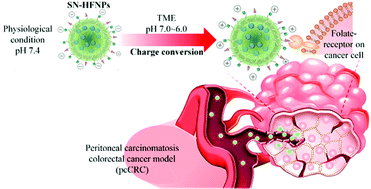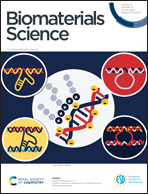Combo-targeted nanoassemblies as a chemotherapy delivery system against peritoneal carcinomatosis colorectal cancer†
Abstract
Peritoneal carcinomatosis colorectal cancer (pcCRC) is one of the most challenging cases in clinical treatment due to its aggressive characteristics and diagnostic limitations, impeding the therapeutic efficacy of chemotherapy. In this study, a poly(lactic-co-glycolic acid) nanoparticle (NP)-based drug delivery system capable of encapsulating the chemodrug SN38 and enhancing drug accumulation in metastatic tumors was developed for the treatment of pcCRC. The SN38-loaded NPs with a diameter of ca. 160 nm were decorated with N-acetyl histidine-modified D-α-tocopheryl polyethylene glycol succinate (TPGS) and folate-TPGS on their surfaces for enhancing drug accumulation through surface charge conversion in a mildly acidic tumor microenvironment and further allowing the NPs to selectively target the folate receptor-overexpressed colon cancer cells. This hierarchically targeted drug delivery strategy improved not only the highly enhanced cellular uptake of drug-loaded NPs, but also the prominent anticancer effect against CT26 cancer cells in vitro. In vivo studies demonstrated the sound tumor inhibition of the SN38-loaded NPs in terms of large reductions in both tumor size and nodule number and prolongation of the survival time of pcCRC-bearing mice, indicating their high therapeutic potential for the practical treatment of pcCRC.



 Please wait while we load your content...
Please wait while we load your content...